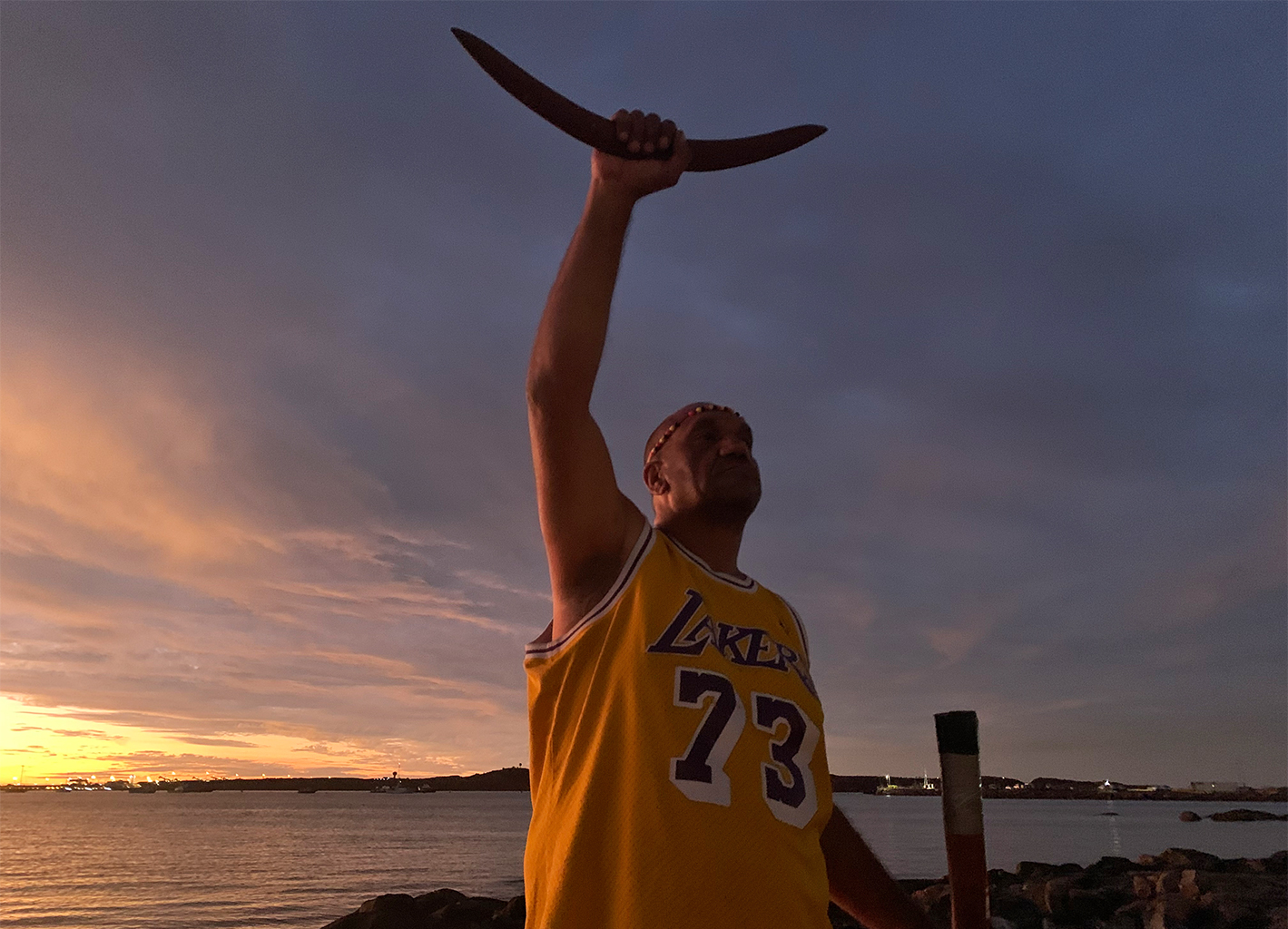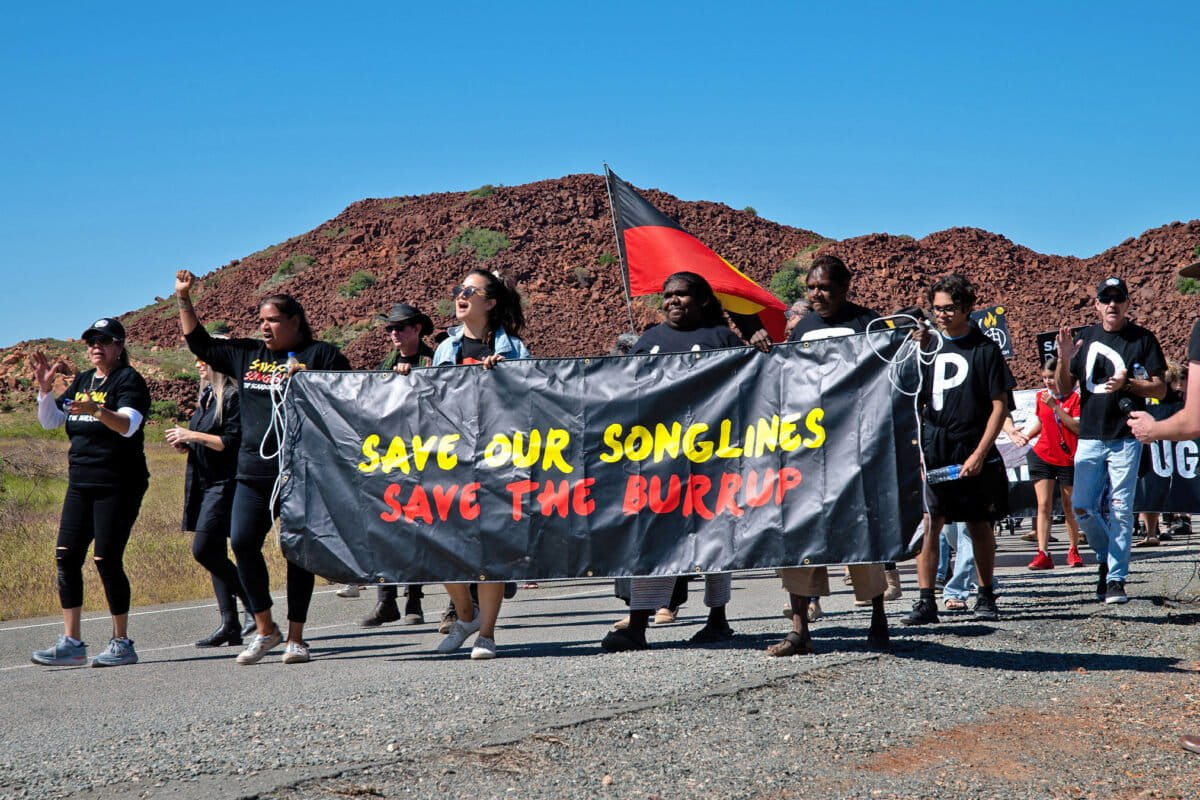- The Indigenous ancestral land of Murujuga in Western Australia is home to the world’s oldest and largest collection of petroglyphs, which would be partially destroyed by the country’s biggest fossil fuel project, the Burrup Hub, owned by Woodside Energy.
- As the company argues more gas is needed, direct action tactics by protesters, like releasing non-toxic stench gas or painting on art, have erupted across the state, as well as crackdowns by the police who have begun imposing the strongest form of charges on activists — some facing up to 20 years in prison.
- This is on trend with a general increasing intolerance toward environmental protesters in Australia and an uptick in the use of direct action by protesters who feel the time is running out to meet climate targets and protect endangered species.
- Environmentalists and researchers worry the project will endanger marine life through seismic blasting and say studies show it is not necessary to meet the country’s energy needs.
BRISBANE, Australia — Formed billions of years ago from volcanic magma, the red rocks and hills of Murujuga arise in striking contrast to the surrounding green native grasses.
This area, in what is known today as Western Australia (WA), holds the world’s largest and oldest collection of petroglyphs, dating back at least 40,000 years. Described as a “bible” for local Indigenous groups, some of the rocks even depict the now-extinct Tasmanian tiger (Thylacinus cynocephalus). Murujuga also encompasses 42 islands that are surrounded by passageways for various migratory whale and dolphin species.
All this dynamic land is tied together by the Turtle Dreaming story. It details how the freshwater meets the ocean through the acts of a turtle, says Raelene Cooper, a Mardudhunera woman and former board member of the Murujuga Aboriginal Corporation. This is one of the greatest creation stories for the Indigenous groups, referred to as original custodians — as in caretakers — of Murujuga.
“We have an enormous responsibility in terms of creating a safe space for all plant life, land animals, marine animals and the underwater systems and especially the … connection with the rock art,” Cooper tells Mongabay.
And part of this landscape is an expanding industrial site that protrudes from the rich, red earth.
Environmentalists and Indigenous advocates say the sacred site is threatened by the upcoming expansion planned by Australia’s largest petroleum company, Woodside Energy. The project entails expanding two processing plants and building two new offshore gas fields in what will produce billions of metric tons of carbon emissions over 50 years, conflict with the nation’s climate targets, endanger pygmy blue whales (Balaenoptera musculus brevicauda) through seismic blasting and further destroy the sacred rock art, they say. Woodside has started dredging to make way for gas wells in critical breeding habitat for endangered hawksbill turtles (Eretmochelys imbricata).


This development, named the Burrup Hub project, is Australia’s largest fossil fuel project, which Woodside and the state government say is crucial for the stability of the international and domestic economy.
“While activists are claiming WA needs to get off gas, the opposite is in fact true. The government’s own forecasts show that more gas will be needed in WA as we make the transition to renewables in the years ahead,” wrote Woodside CEO Meg O’Neill in a local paper. “Without it, jobs and energy security are at risk and cost of living pressures will rise.”
However, research by The Australia Institute disputes this. It suggests that the country already has more than enough gas for the future. The problem is not a lack of supply, the researchers say, but that Australia’s existing gas is overwhelmingly exported.
In response to the conflict, protests by Indigenous custodians and environmentalists, along with subsequent crackdowns by the state, have erupted across Western Australia in recent years.
Desmond Blurton, an Indigenous Ballardong Noongar custodian, is one of the protesters. He undertakes direct action tactics as lead Indigenous spokesperson of Disrupt Burrup Hub, a campaign that has rattled the bones of the WA government, Woodside and much of local media. In 2022, Woodside donated thousands to the ruling Labor Party and a leading local media group has a stake in Woodside Energy.
Ongoing direct action and resistance to the gas plant has included forcing the evacuation of Woodside sites using nontoxic gas, spraying graffiti on buildings and an iconic painting and interrupting an Australian football game. In retaliation, police and state crackdown on protesters has been severe and imposed the strongest form of charges on activists.
Since the start of the year as the gas development projects ramped up, campaigners, including one as young as 19, have had their homes raided and been pulled over in their cars at gunpoint by state security police. Authorities have also seized their possessions and handed them gag orders.


Little tolerance left for protests
In recent years, Australia, following suit of countries in Europe, has put increasing pressure on climate protesters, raising penalties and using existing laws in ways civil liberties lawyers call draconian.
In New South Wales, where protestors have been fighting logging on Indigenous Gumbaynggirr land, the state government introduced penalties in 2022 targeting people whose actions disrupt businesses and economic activity, such as by blocking roads and ports, with up to two years in maximum security prison and fines of AU$22,000 (about $15,000).
In the same year, the state of Victoria also introduced new measures targeting anti-logging protesters with up to 12 months in prison or $21,000 in fines. Similarly, in Tasmania, home to old-growth forests, environmental activists “now face fines of AU$13,000 [$8,200] or two years in prison,” according to Human Rights Watch. In Queensland, locking devices are banned, and those using them in protest face up to two years in prison and/or an AU$6,000 ($3,800) fine.
Most recently, in May this year, the South Australian state government passed new laws increasing fines for obstructing a public place from AU$750 ($475) to AU$50,000 ($31,600) and including possibility of three months in prison.
While WA hasn’t specifically changed laws to target and penalize climate protestors, the state has escalated its crackdown through the ways existing laws are applied. For example, multiple campaigners from Disrupt Burrup Hub have been charged with conspiracy to commit an indictable offense as well as handed violence restraining orders.
Similar to Australian police tactics and crackdowns that gained global attention during COVID-19 protests, the WA Police Force has used surveillance on climate campaigners in Perth, enabling state security police to make arrests before planned actions have taken place.

A senior lawyer at the Human Rights Law Centre (HRLC), David Mejia-Canales, says the orders used on climate defenders in Australia are concerning.
“As humanity enters the ‘era of global boiling,’ Woodside and the multibillion-dollar fossil fuel industry are trying to send a chilling message to anyone who dares to speak out: You will be intimidated and silenced,” Mejia-Canales says.
According to a spokesperson at the WA Police Force, the state security police is aligned with community safety and security.
“[We] undertake investigations into acts of individuals/groups who have (or are alleged to have) undertaken criminal activities impacting upon community safety/well-being, with a political, religious or ideological motivation,” the spokesperson tells Mongabay. “These types of activities sit outside of the right to engage in lawful protest.”
In the case of Burrup Hub protests, a few non-Indigenous protesters used a non-toxic stench gas to force the evacuation of Woodside sites — evacuating several thousand Woodside workers and stopping work for the day in one case. In April, another protester was charged with Aggravated Burglary for attempting an evacuation using smoke flares.
But the HRLC says the charges have gone too far. It’s particularly concerned with the way Western Australian authorities are using violence restraining orders, which are meant to be used to protect women and children from family violence perpetrators.
“These orders have been sought in unprecedented circumstances, despite there being no accusations that the protesters have at any stage used or threatened violence against anyone at Woodside,” Mejia-Canales says. “We have never seen restraining orders, which are designed to protect people fleeing family violence, used to silence dissent.”








Other ways to protest
Recently, Blurton held a solo cultural protest outside the home of Woodside board member Ben Wyatt.
“I do get worried about a police officer shooting me, or being arrested, because I am very vulnerable if I go into custody; I could become a statistic,” says Blurton, who is also deputy chair of the watchdog organization Deaths in Custody Watch Committee. Indigenous deaths in custody are at their highest since records have been kept, according to a report this year by the federal Productivity Commission.
Woodside originally chose the site for its first gas project, North West Shelf in Murujuga, in 1978 without the consent of original custodians. The necessity to do so was not yet recognized as an Indigenous right. In the time since, the company destroyed an estimated 5,000 pieces of sacred rock art during construction, some of which Woodside crushed into the ground to make roads out of. Emissions from Woodside’s processing plants — specifically nitrogen oxides — also actively destroy what is left of the Murujuga rock art.
In response, a group of Murujuga custodians formed the group Save Our Songlines to stop the future destruction of rock art using the law — avoiding charges for their protest. The rock art holds songlines, which they believe map out the paths of creation and need to be passed down through generations.
Once the company declared it would start seismic blasting, an action that would impact songlines and the marine animals that carry them, Raelene Cooper, the lead spokesperson of Save Our Songlines, immediately submitted an injunction in the Federal Court to pause the actions. It was successfully granted in September.
“We’re not fighting a small company, we’re fighting a global network of fossil fuel power and that’s exactly what these companies are, they have a lot of money. They have a lot of lawyers,” she tells Mongabay. Woodside said it would work with the country’s gas regulator to gain new approval for the blasting.

Cooper is also waiting for a Federal Court decision on her previously filed application for a review of the one of the gas fields, Scarborough gas field, which was undertaken without consultation with original custodians — today a recognized right.
According to a spokesperson at Woodside, it is company policy to avoid damage or disturbance to Indigenous cultural heritage and, if avoidance is not possible, to minimize and mitigate the impacts, in consultation with communities and custodians.
But for the Indigenous protesters, protection of sacred rock art and their songlines is unavoidable.
“The seismic blasting Woodside risks killing migratory whales who carry songlines as they travel along the coast,” says Cooper. “It creates havoc and turmoil … for the animals that follow behind them — the dugongs, turtles, dolphins, stingrays; the impact is devastating and our songlines stop coming in.”
Banner image: A group of Murujuga custodians formed the group Save Our Songlines to stop the future destruction of rock art using the law. Image by Nancie Miles-Tweedie.
What does land mean to Australia’s Indigenous groups fighting logging?
Related listening from Mongabay’s podcast: A conversation with Cultural Survival’s Daisee Francour and The Oakland Institute’s Anuradha Mittal about securing Indigenous land rights within the context of a global push for land privatization. Listen here:
FEEDBACK: Use this form to send a message to the author of this post. If you want to post a public comment, you can do that at the bottom of the page.
